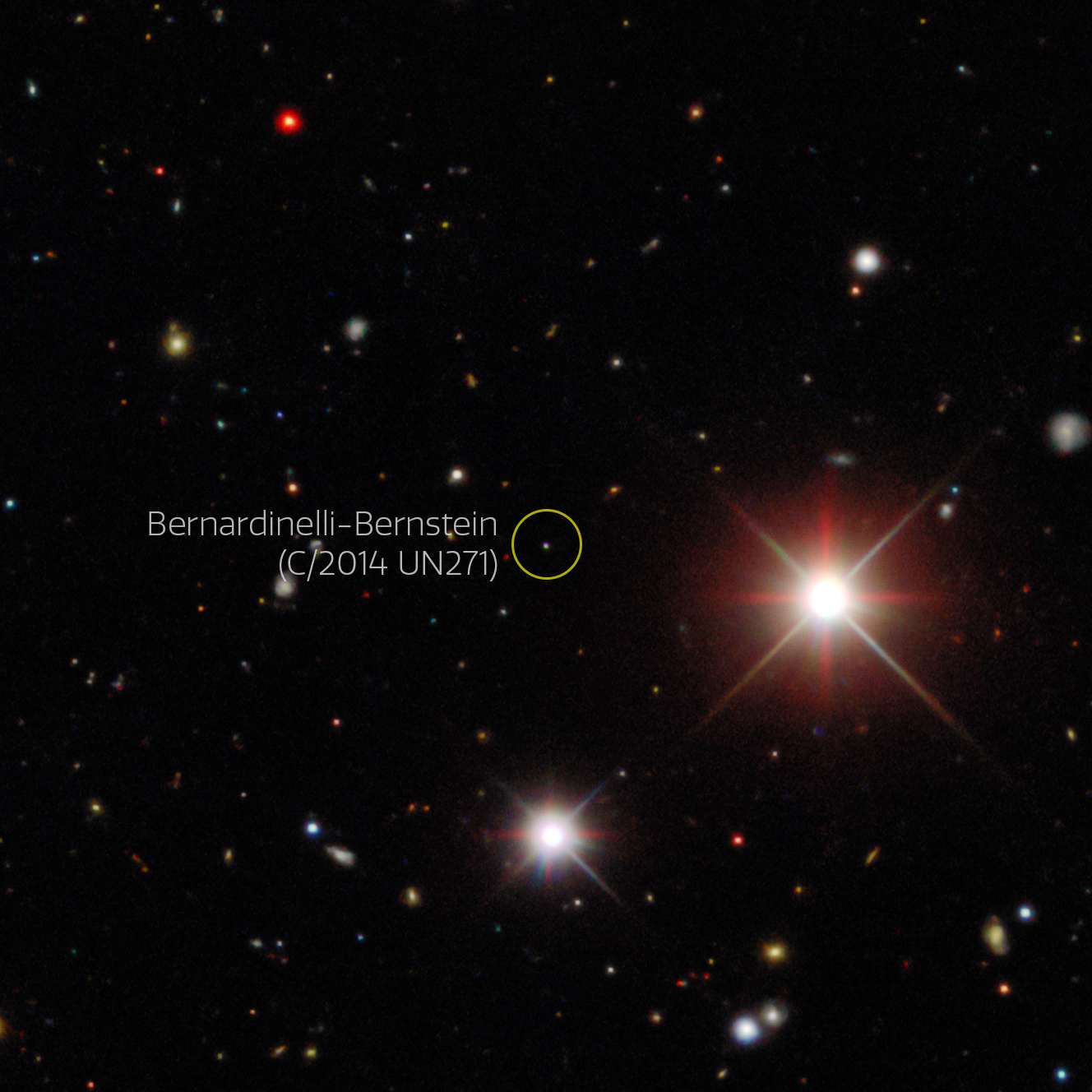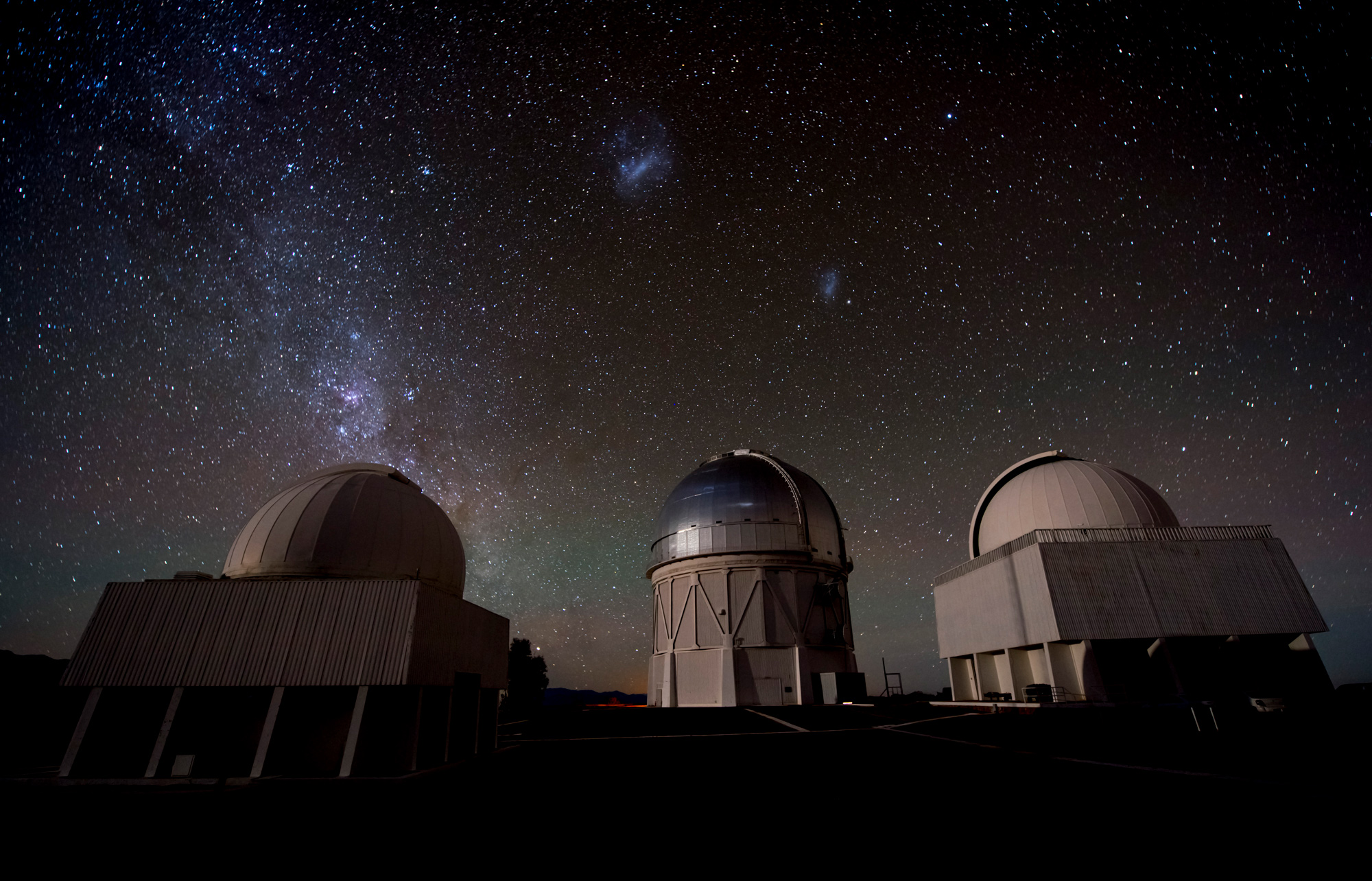“Once in a lifetime” is often used figuratively, but in the case of the discovery of a new comet—one that only visits our celestial neighborhood every five million years—the phrase is quite literal.
Comets have been a cornerstone of astronomical investigation since antiquity, with evidence of detailed observations dating back to ancient Greece. What were historically seen as portents of doom are now an invaluable tool for researchers searching for clues about the early solar system. The newly discovered comet occupies a special spot amongst the current pantheon of known comets, as it is the largest ever discovered in modern times, overtaking 1995’s Hale-Bopp.
Pedro Bernardinelli, GR’21, a graduate of the physics and astronomy doctoral program, first spotted what became the Bernardinelli-Bernstein comet this past spring while he was combing through data captured by the Dark Energy Survey (DES), a collaborative project involving universities and institutions around the globe. DES has released nearly 700 million images of stars and galaxies and is an invaluable resource for researchers and students worldwide. In Bernardinelli’s case, he was using software he designed to look for Trans-Neptunian objects (TNOs), often described as minor planets.
“Trans-Neptunian objects are relics from the early days of the solar system. Frozen inside them is information about what conditions were like,” says Gary Bernstein, Reese W. Flower Professor of Astronomy and Astrophysics, and Bernardinelli’s mentor in the researching of TNOs. “Their locations can tell us, for example, that Jupiter, Saturn, Uranus, and Neptune did not form where we see them now.”

Gary Bernstein, Reese W. Flower Professor of Astronomy and Astrophysics
The Bernardinelli-Bernstein comet originated not in the space beyond Neptune, where TNOs are generally found, but from an even more distant reservoir known as the Oort cloud. Comets found in this region are long-period, taking vast amounts of time to make a return trip to our corner of space, unlike Halley’s Comet, the best-known of the “periodic” comets that return often enough to be seen twice in a human lifetime.
The mysteries of space have fascinated Bernstein ever since he watched the moon landing at age seven. He describes his research as being focused on “extracting gems of astronomical knowledge from large piles of astronomical images.” This consists of using methods like weak gravitational lensing, which refers to the careful examination of how the deflection of light by gravity subtly changes the shapes of distant galaxies, to hunt down new objects and better understand phenomena like dark matter and dark energy.
Bernstein’s research focus struck a chord with Bernardinelli when Bernstein spoke at a seminar series for first-year graduate students. “Masao Sako [Professor and Undergraduate Chair of Physics and Astronomy] and I explained the projects we’d been working on, including the search for TNOs,” says Bernstein. “Pedro approached us, and since he joined in the research, he has discovered over 800 TNOs—about a quarter of all the ones that are known. Discoveries of this scale usually require a team of a dozen people or so, but Pedro has done much of the work himself.”

Pedro Bernardinelli, GR’21
TNOs are monitored by observing how they move with respect to the stars. “The software is essentially trying to spot anything that’s moving,” says Bernardinelli, who, since he was a child, wanted to “understand how things worked,” and thus was drawn to physics. “When it came to Penn, this naturally led me to work with Gary.”
Bernardinelli delved deeper and deeper into his search for TNOs, until, near the end of his observation period, he spotted a celestial body he could immediately tell was not a TNO, but something else entirely.
“We could tell this object had a comet-like orbit because we could track it using archived DES images that dated back to 2014,” says Bernstein. “Once you see an object in the sky more than three times or so, you can use Newton’s laws to figure out what its orbit is.”
The Bernardinelli-Bernstein comet is an extraordinarily large specimen. “Most comets are around 10 kilometers across and would fit between the Penn campus and the Philadelphia airport. This newly discovered comet is, by an educated guess, more like the distance from the Penn campus to Baltimore.”
The telltale attribute of a comet is, of course, its tail, and not just in a pop culture sense. Indeed, a tail must be witnessed through scientific imaging before an official comet designation is verified.
“We didn’t see a tail in our pictures, so I sent a request to the Hubble Space Telescope, which would get us the clearest picture. They have an emergency request program, but we were turned down fairly promptly due to capacity, then the space telescope was broken for the next month,” Bernstein says.
Without confirmation of a tail, the researchers were in a holding pattern.
What exactly gives a comet its all-important tail? Bernstein says that these “dirty snowballs” [a term coined by American astronomer Fred Lawrence Whipple] consist largely of ices of water and other molecules, like carbon dioxide, that evaporate during orbit, mixed with dust and rocks.
“When we witness a comet, it is already dying—coming apart, freeing some of the more solid debris that creates a tail,” says Bernstein. “Since the solar system is four billion years old, comets like this one can’t have been coming into our neighborhood for very long, because they would’ve evaporated away into a cloud of pebbles only millions of years ago, which is a short time for astronomy. So, besides being just visually spectacular things that get people’s attention, they are of interest because they’re like little time capsules from the earlier days of the solar system.”
Because they couldn’t capture an image of the comet’s tail using the images they had on-hand, the pair decided to take a leap. “We released what we had on the object into the public domain and allowed people to go after it, instead of keeping it in our vest pockets.”
They never could have anticipated the response.
“It was really unexpected, the amount of feedback we got from the community once we announced the discovery,” says Bernardinelli. “I was on a quick trip to Seattle and my phone wouldn’t stop ringing from people sending me messages on Twitter or emails, and saying, ‘Hey, this is cool. Can I send more data? Do you mind if I talk about it?’ It was a very crazy week.”
Most comets are around 10 kilometers across and would fit between the Penn campus and the Philadelphia airport. This newly discovered comet is, by an educated guess, more like the distance from the Penn campus to Baltimore.
Within 24 hours of their announcement of the object to the Minor Planet Center and various bulletin boards, an amateur astronomer captured images of a tail, and in another day or two, another had confirmed the same finding.
As of June 21, 2021, it was official—it’s a comet. And though the pair had asked that it be called “Comet DES” after the Dark Energy Survey, because the discovery had become a collaborative effort, the International Astronomical Union insisted on it bearing Bernstein’s and Bernardinelli’s names.
Bernstein says of the discovery, “There’s a good quote that I learned from watching The Incredibles, when the character Edna Mode says, ‘Luck favors the prepared, darling,’ which I read is actually based on a quote from Pasteur [a renowned French chemist and microbiologist]. And Pasteur said something very apt: ‘Chance favors the prepared mind.’ So, in this case, we were well prepared because the software was designed to find objects that orbit just beyond Neptune, but we got lucky to find something that was zooming past Neptune from much, much farther away.”
Once the comet was made official, the excitement finally started to sink in. “I started telling this to my family and they were like, ‘Wait, explain this to me again,’” Bernardinelli laughs. “And at some point, I got contacted by a senior member of the International Astronomical Union saying that the object was going to be renamed in mine and Gary’s name, and I tell this to my wife and to my parents, and they were really excited. My dad said at some point his boss called him to congratulate him, because it made it into major Brazilian media. So, my entire family, seeing our last name being thrown around in the media—it was totally wild.”
As more research is completed on the comet, it provides a clearer window through which to track its epic journey into view. Bernstein says it likely originates from a family of comets that were kicked out by Jupiter in the early days of the solar system and thrown into an orbit that wasn’t quite fast enough to leave the Sun entirely.
“It’s basically been in a very, very distant orbit, and that means it takes millions of years to come around each time,” says Bernstein, referring to the comet’s long-period nature. “To put the distance of the journey into context, Neptune is around 30 AU [one AU, or “astronomical unit,” indicates the distance from Earth to the Sun], but the comet travels 40 thousand AU away before returning. So, occasionally, one of these objects, which has lived out even further beyond than Neptune, where ice is happy to last billions of years, comes into the inner solar system and becomes a comet.”
With current imaging technology, the researchers will likely be able to monitor the Bernardinelli-Bernstein comet up until about the year 2040, and maybe even beyond if technology improves. No stranger to innovation regarding imaging technology, Bernstein, during his time as a postdoc at Bell Labs, designed an electronic detector for a telescope. This same detector was used by physicists Saul Perlmutter, Adam Riess, and Brian Schmidt in their discovery of the accelerating expansion of the universe, which won the trio a Nobel prize in 1998. To this day, Bernstein is contributing his expertise to upgrading telescope technology used in the DES.
So, what does the future hold for the researchers and their comet?
“I will certainly follow the news of what other observers might find; I’m pretty sure that already other professional telescopes have been pointed at it. And I’d like to pursue time with the Hubble Space Telescope to get a better picture of the comet’s tail,” says Bernstein. “There’s a famous saying about comets that they’re like cats—they have tails, and they do whatever they want. And that they seem to each have their own individual behavior.”
There’s a famous saying about comets that they’re like cats—they have tails, and they do whatever they want. And that they seem to each have their own individual behavior.
The pair finished writing a paper detailing more of the findings this past summer. Bernardinelli since began a postdoctoral fellowship at the University of Washington where he’ll be working to develop tools to discover more TNOs and other celestial bodies.
“Right now, as I understand, this is the third comet found at a vast 15 astronomical units,” Bernardinelli says. “It will be interesting to see as it develops how similar or different it is to the other two that were found at this distance as well, and then see whatever else we find in the next few years. Because there are certainly going to be more coming, as more projects measure the sky find these sorts of objects.”






